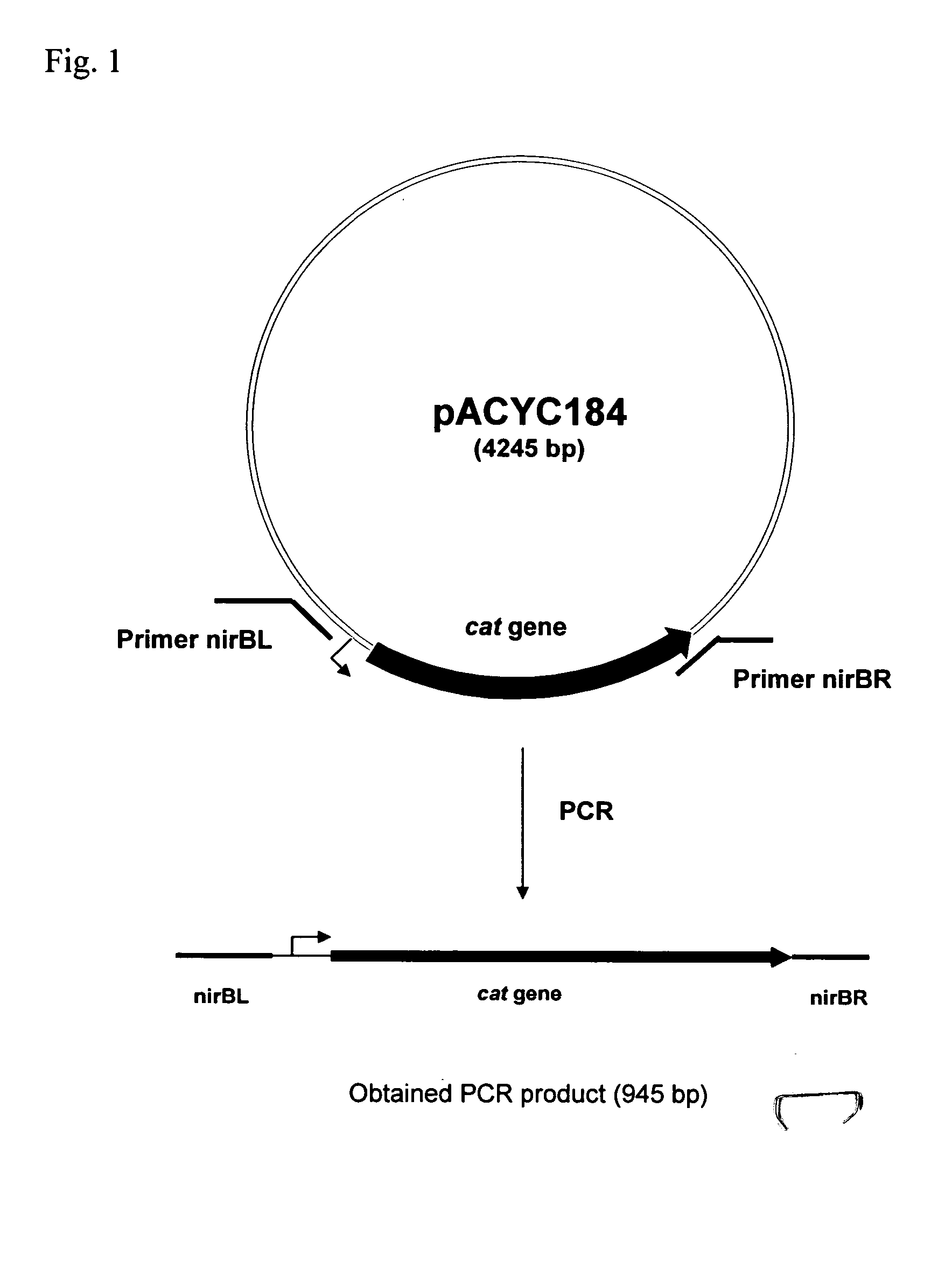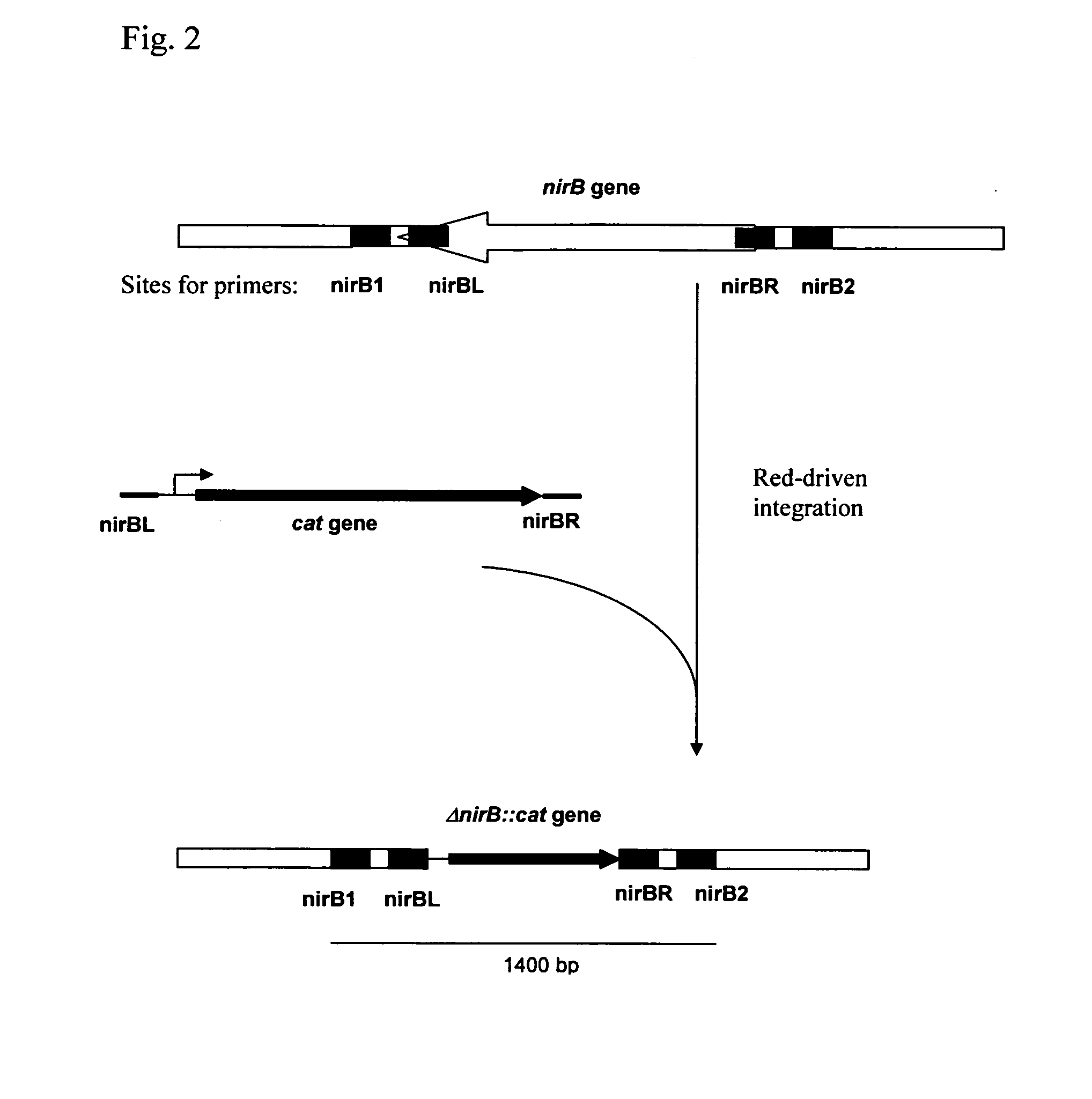Method for producing L-amino acid using bacterium of Enterobacteriaceae family, having nir operon inactivated
a technology of enterobacteriaceae and l-amino acid, which is applied in the field of microorganisms, can solve the problems of defective nitrite reduction of cysg mutants, and achieve the effect of enhancing the productivity of l-amino acid producing strains
- Summary
- Abstract
- Description
- Claims
- Application Information
AI Technical Summary
Benefits of technology
Problems solved by technology
Method used
Image
Examples
example 1
Construction the Strain having an Inactivated nir operon
[0051] Deletion of the nirB Gene
[0052] Deletion of the nirB gene was performed by the method first developed by Datsenko and Wanner (Proc. Natl. Acad. Sci. USA, 2000, 97(12), 6640-6645) and called “Red-driven integration”. According to this procedure, the PCR primers nirBL (SEQ ID NO: 1) and nirBR (SEQ ID NO: 2), which are homologous to both regions adjacent to the nirB gene, and a gene conferring antibiotic resistance in the template plasmid were constructed. Plasmid pACYC184 (NBL Gene Sciences Ltd., UK) (GenBank / EMBL accession number X06403) was used as a template in PCR reaction. PCR was conducted as follows: denaturation step for 3 min at 95° C.; profile for two first cycles: 1 min at 95° C., 30 sec at 50° C., 40 sec at 72 ° C.; profile for the last 25 cycles: 30 sec at 95° C., 30 sec at 54° C., 40 sec at 72° C; final step: 5 min at 72° C.
[0053] The obtained 945 bp PCR product (FIG. 1, SEQ ID NO: 3) was purified by agaro...
example 2
Production of L-arginine by E. coli Strain with Inactivated nirB Gene
[0059] Both E. coli strains 237 and 237AnirB::cat were grown overnight at 37° C. on L-agar plates. The strain 237ΔnirB::cat plate also contained chloramphenicol (20 μg / ml) . Then one loop of the cells was transferred to 2 ml of minimal medium for fermentation in the 20×200 mm test tubes. Cells were grown for 72 hours at 32° C. with shaking at 250 rpm.
[0060] After the cultivation, the amount of arginine which accumulated in the medium was determined by paper chromatography using arginine (1 g / l and 2 g / l) and glutamic acid (1 g / l and 2 g / l) as controls. The paper was developed with a mobile phase: n-butanol:acetic acid:water=4:1:1 (v / v). A solution of ninhydrin (0.5%) in acetone was used as a visualizing reagent.
[0061] The results are presented in Table 1.
[0062] The composition of the fermentation medium (g / l):
Glucose67.0Yeast extract5.0(NH4)2SO435.0KH2PO42.0MgSO4.7H2O2.0Thiamine (Vitamin B1)1.0CaCO325.0L-isol...
PUM
 Login to View More
Login to View More Abstract
Description
Claims
Application Information
 Login to View More
Login to View More - R&D
- Intellectual Property
- Life Sciences
- Materials
- Tech Scout
- Unparalleled Data Quality
- Higher Quality Content
- 60% Fewer Hallucinations
Browse by: Latest US Patents, China's latest patents, Technical Efficacy Thesaurus, Application Domain, Technology Topic, Popular Technical Reports.
© 2025 PatSnap. All rights reserved.Legal|Privacy policy|Modern Slavery Act Transparency Statement|Sitemap|About US| Contact US: help@patsnap.com


